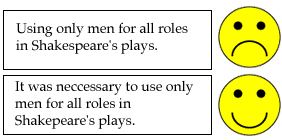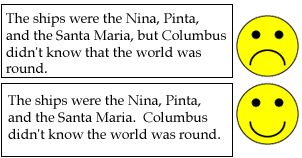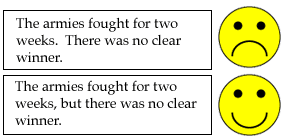C
onstruct complete sentences.
- Make sure that each sentence that you
write is a complete sentence. It must have a complete thought
and have a subject and a verb. (e.g., "Using only men
for all roles in Shakespeare's plays," is not a complete
thought. It has to be changed to a complete thought, such as,
"It was necessary to use only men for all roles in Shakespeare's
plays.").
- Read your sentences aloud to make sure
that you are writing a complete thought. Ask yourself if the
sentence sounds right.
|
 |
C
onstruct compound sentences.
- Make your sentences more interesting
by using compound sentences. Compound sentences include two
independent clauses, both of which are sentences that can stand
alone (e.g., "The armies fought for two weeks, but there
was no clear winner.").
- Avoid using short simple sentences
(e.g., "The armies fought for two weeks. There was no
clear winner.").
- Use conjunctions such as but, and,
and so to connect the two independent clauses.
|
|
C onstruct
complex sentences.
- Make your sentences more interesting
by constructing complex sentences. Complex sentences include
an independent clause, which is a complete sentence that can
stand alone, and a dependent clause, which cannot stand alone
(e.g., "New diseases were introduced in the Indian population
after Columbus came to the New World." The sentence
part New diseases were introduced in the Indian population
is a complete sentence and can stand alone, but the part after
Columbus came to the New World is not a complete sentence
that can stand alone.).
- Avoid use of simple sentences (e.g.,
"Columbus came to the New World. He introduced new diseases
in the Indian populations.").
- Use conjunctions such as when, after,
before, etc. to connect the clauses.
|

|
I nclude
only related ideas.
- Avoid run-on sentences that have unrelated
ideas in them (e.g., "The ships were the Nina, Pinta,
and the Santa Maria, but Columbus didn't know that the world
was round."). Make sure all the ideas in your sentences
are related to a main topic. If not, use two sentences.
|

|
A
greement of sentence parts.
- Make sure that the subject and the
verb agree. For example, in the sentence "Use of tools
were important to the caveman," the subject is use
of tools and the verb should be was, not were.
Use of tools was important to the caveman.
- Make sure that pronouns agree. For
example, in the sentence, "Everyone was happy because
he (should be they) were going to get money."
- Make sure that articles (i.e., a
and an) agree. For example, in the sentence "A
equal society begins with (there should be an "an"
in place of the "A") equally excellent schools."
|

|
|







